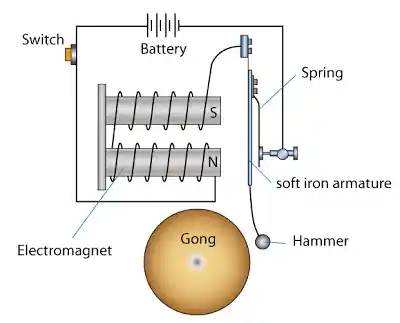Have you ever wondered how the bell in your school or at your front door works? In this article we’ll explore the fascinating science behind electric bells. This easy-to-understand guide will answer all your curious questions about how electric bells use electromagnetism to create sound and how their different parts work together to make that familiar ringing noise.
Table of Contents
What is an Electric Bell?
An electric bell is more than just a device that makes a ringing sound; it’s a practical application of electromagnetism. It beautifully demonstrates how electrical energy can be transformed into mechanical energy, creating the familiar ding-dong we often hear.
Key Components of an Electric Bell
Electromagnet
- This is the heart of the electric bell.
- It’s essentially a coil of wire wrapped around an iron core.
- When electricity passes through the coil, it turns the iron core into a magnet.
Armature
- The armature is a movable iron strip, usually positioned close to the electromagnet.
- When the electromagnet is powered, it attracts the armature due to its magnetic field.
Spring
- The spring is connected to the armature and plays a crucial role in the bell’s mechanism.
- Its primary function is to pull the armature back to its original position after each strike.
Hammer
- Attached to the armature, the hammer is what actually hits the bell to produce sound.
- When the electromagnet activates and pulls the armature, the hammer moves and strikes the gong.
Gong
- The gong is the metal part that produces the sound when hit by the hammer.
- Its position and size can affect the sound quality and volume of the bell.
Switch
- The switch controls the flow of electricity to the electromagnet.
- Pressing the switch completes the electric circuit, allowing the current to flow.
Electric Bell Working Principle

The electric bell is a fascinating device that uses the principles of electromagnetism to generate sound. Here’s a detailed look at how it works
Completing the Circuit
- When you press the switch of the electric bell, you complete an electrical circuit.
- This action allows electric current to flow through the wires of the circuit.
Activation of the Electromagnet
- The flow of current powers the electromagnet in the bell.
- An electromagnet, unlike a permanent magnet, only has a magnetic field when electric current flows through it.
- In the electric bell, the electromagnet becomes active (magnetised) as soon as the switch is pressed and current flows.
Attraction of the Armature
- The activated electromagnet then exerts a magnetic force on a piece of iron called the armature.
- The armature is attached to a spring and a hammer (or striker).
- When the electromagnet is energised, it attracts the armature towards it.
Striking the Gong
- The movement of the armature causes the hammer attached to it to move.
- The hammer strikes the gong, which produces the ringing sound of the bell.
Breaking the Circuit
- The action of the hammer hitting the gong also causes a break in the circuit.
- This break happens because the movement of the armature changes the alignment in the circuit, temporarily stopping the flow of current.
Deactivation of the Electromagnet and Resetting
- When the circuit breaks, the electromagnet loses its magnetism.
- The spring attached to the armature pulls it back to its original position, away from the electromagnet.
- This resetting of the armature also re-establishes the contact in the circuit.
Repetition of the Process
- If the switch remains pressed, current again flows through the circuit, reactivating the electromagnet.
- The whole process, from attracting the armature to resetting it, repeats as long as the switch is pressed.
- This continuous cycle results in the repetitive ringing of the bell.
Also Check – Electromagnets- A Guide for Upper Primary Students
The Electromagnet in Electric Bells
The electromagnet is a pivotal component in an electric bell, and understanding its role can deepen our appreciation of this common device.
Nature of the Electromagnet
- An electromagnet in an electric bell is different from permanent magnets because it can be turned on and off.
- This ability to switch states is what makes it so useful in an electric bell.
Also Check – The Electromagnet, Magnetic Coil and Permeability
Creating the Magnetic Field
- When the bell’s switch is pressed, electricity flows through the wire coiled around the iron core of the electromagnet.
- This flow of electricity generates a magnetic field around the iron core, effectively turning it into a magnet for as long as the current flows.
Attracting the Armature
- The magnetic field generated by the electromagnet is powerful enough to pull the armature, a piece of iron, towards itself.
- This attraction happens because the iron in the armature is drawn towards the magnetic field.
The Role in Sound Production
- The electromagnet doesn’t directly create the sound. Instead, its on-off magnetic field is crucial for moving the armature, which in turn, moves the hammer to strike the gong.
- The rapid making and breaking of the electromagnet’s magnetic field lead to the repetitive striking of the gong, creating the continuous ringing sound.
The Importance of Timing
- The precise timing with which the electromagnet turns on and off is crucial for the effective working of the bell.
- This timing ensures that the armature and the hammer move back and forth at just the right speed to create a consistent ringing sound.
The electric bell is a simple yet ingenious application of electromagnetism. Understanding how it works not only helps students grasp key scientific principles but also nurtures curiosity about the everyday devices around us.
